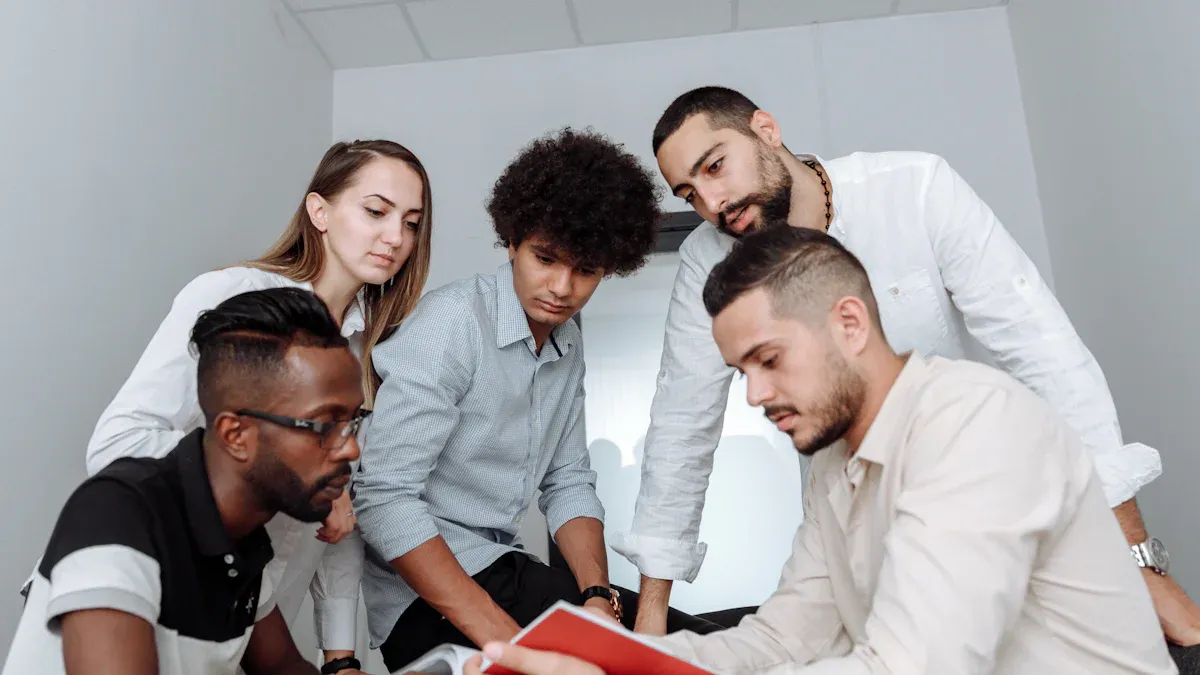How to Create Effective Educational Materials for Diverse Learners

Creating educational materials that embrace inclusivity, accessibility, and adaptability ensures every learner has an equal opportunity to succeed. When you design materials for diverse audiences, you foster empathy and reduce barriers to learning. For example, inclusive classrooms have grown significantly, with 65% of students with disabilities participating in 2019 compared to 46.5% in 2000. This shift highlights the importance of accessible learning environments. Adaptive technologies also enhance engagement by offering personalized lessons tailored to individual needs. By developing educational materials for diverse audiences, you empower learners to thrive academically and emotionally.
Key Takeaways
Learn about your audience by studying their age, culture, and likes. This helps you make materials they can understand and enjoy.
Make sure your designs are easy for everyone to use. Offer different formats and work with assistive tools to help all learners.
Use clear and simple words in your materials. Stay away from hard words and long sentences so everyone understands.
Ask learners for feedback to make your materials better. Use surveys and tests to find problems and improve learning.
Use digital tools and games to make learning fun. Interactive features and personal lessons can keep learners interested and help them remember.
Understanding Your Audience
Creating effective educational materials starts with understanding your audience. By identifying who your learners are, you can design content that resonates with their unique needs and preferences.
Identifying Learner Demographics
To tailor your materials, you need to consider key demographic factors. These include geographic region, school level, and the socioeconomic context of the learners. A recent survey highlights the following characteristics:
School Characteristic | Description |
|---|---|
Region | Data is disaggregated by geographic region across the U.S. |
Locale | Information is categorized based on urban, suburban, and rural locales. |
School Level | Results are available for different school levels such as elementary, middle, and high schools. |
School Size | Data includes estimates based on the size of the school (e.g., small, medium, large). |
Percent Students of Color | Estimates are provided regarding the percentage of students of color in each school. |
School Neighborhood Poverty Level | Data reflects the poverty levels of neighborhoods where schools are located. |
This information helps you understand the broader context in which your learners operate. For example, students in rural areas may have different access to resources compared to those in urban schools.
Recognizing Cultural and Linguistic Diversity
Cultural and linguistic diversity plays a significant role in how learners engage with educational materials. You should consider the languages spoken at home, cultural norms, and traditions that might influence learning. Incorporating multilingual resources or culturally relevant examples can make your materials more relatable. For instance, using examples from diverse cultural backgrounds fosters inclusivity and helps learners feel represented.
Assessing Learner Needs and Preferences
Every learner has unique needs and preferences. Some may require visual aids, while others benefit from hands-on activities. Conduct surveys or gather feedback to understand what works best for your audience. You can also observe how learners interact with existing materials to identify gaps. By addressing these needs, you ensure that your materials are both engaging and effective.
Developing educational materials for diverse audiences requires a deep understanding of who your learners are. When you take the time to assess demographics, cultural diversity, and individual preferences, you create resources that truly support learning.
Principles for Developing Educational Materials for Diverse Audiences
Designing for Universal Accessibility
When you design educational materials, universal accessibility should be a top priority. This approach ensures that all learners, regardless of their abilities, can engage with the content. Universal Design for Learning (UDL) principles provide a framework for creating accessible materials. For example, the AEM Center emphasizes that accessible materials are essential for implementing UDL, which supports diverse learning needs.
Case studies also highlight the success of universal accessibility. One example involves a technical college that adopted UDL principles to improve learning experiences for students with disabilities. Another case showed how a student with ADHD benefited from printed materials and accessibility tools, which enhanced their focus and time management. These examples demonstrate how accessible designs can positively impact learners.
To achieve universal accessibility, consider using multiple formats, such as digital and print, and ensure compatibility with assistive technologies. This approach not only benefits students with disabilities but also enhances the learning experience for everyone.
Using Clear and Simple Language
Clear and simple language improves comprehension for diverse learners. Research supports this practice, showing that straightforward language helps students decode and understand information more effectively. For instance, a study by Hoover and Gough validated the Simple View of Reading, finding a strong correlation between language comprehension and reading success.
You can simplify your materials by avoiding jargon, using short sentences, and breaking complex ideas into smaller parts. Tables, bullet points, and visuals can also make information easier to digest. These strategies ensure that your content is accessible to learners with varying language skills.
Avoiding Stereotypes in Content and Media
Stereotypes in educational materials can alienate learners and perpetuate biases. When developing educational materials for diverse audiences, you should use inclusive language and imagery that reflects a variety of cultures, genders, and abilities. For example, instead of using generic stock photos, choose visuals that represent real-world diversity.
Review your content carefully to avoid reinforcing stereotypes. Inclusive materials foster a sense of belonging and encourage learners to engage more deeply with the content. By promoting equity and representation, you create a positive learning environment for everyone.
Adapting Content for Different Learning Styles

Understanding Learning Styles (Visual, Auditory, Kinesthetic, etc.)
Understanding how learners process information can help you create more engaging materials. While the concept of learning styles—visual, auditory, and kinesthetic—has gained popularity, research shows mixed results regarding its effectiveness. For example, studies by Kavale and Forness (1987) and Kampwirth and Bates (1980) found no consistent educational benefits from tailoring instruction to specific modalities.
Study | Findings |
|---|---|
Kavale and Forness (1987) | Tailoring instruction to students' modality had no educational effect. |
Kampwirth and Bates (1980) | A few studies showed positive effects, but many showed no impact. |
Arter and Jenkins (1979) | Results were inconsistent, similar to Kampwirth and Bates. |
Instead of focusing solely on learning styles, you should aim to create materials that appeal to a broad range of learners. This approach ensures that everyone can benefit, regardless of their preferred method of learning.
Creating Multi-Modal Learning Materials
Multi-modal materials combine different formats, such as text, visuals, and audio, to enhance learning. This strategy works well because it engages multiple senses, making the content more memorable. For instance, pairing written instructions with diagrams or videos can help learners better understand complex concepts.
You can also use tools like interactive slides or digital platforms to present information in various ways. These tools allow learners to choose the format that works best for them. By offering multiple options, you make your materials more inclusive and adaptable.
Encouraging Active and Experiential Learning
Active learning involves engaging learners directly in the process. You can achieve this by incorporating activities like group discussions, hands-on experiments, or problem-solving tasks. Experiential learning takes this a step further by allowing learners to apply knowledge in real-world scenarios.
For example, instead of just reading about ecosystems, students could create a small terrarium to observe how plants and animals interact. This approach not only reinforces theoretical knowledge but also builds critical thinking and problem-solving skills. Active and experiential learning keeps learners motivated and helps them retain information more effectively.
Developing educational materials for diverse audiences requires you to think beyond traditional methods. By understanding learning styles, creating multi-modal resources, and encouraging active participation, you can design materials that truly resonate with your audience.
Accessibility Considerations
Ensuring Compliance with Accessibility Standards (e.g., WCAG)
Adhering to accessibility standards like the Web Content Accessibility Guidelines (WCAG) ensures that your educational materials are usable for all learners, including those with disabilities. The Americans with Disabilities Act (ADA) established these standards to promote equal opportunities. However, studies reveal that many websites fail to meet even basic compliance. For instance, 96.3% of the top one million web homepages do not comply with WCAG. Similarly, most e-government websites in India fail to meet Level A standards, with color and contrast issues being common barriers.
To ensure compliance, you should evaluate your materials against WCAG principles, such as perceivability, operability, and robustness. This process involves using accessible color schemes, providing text alternatives for images, and ensuring keyboard navigation. By meeting these standards, you create an inclusive learning environment that benefits everyone.
Providing Alternative Formats (e.g., transcripts, captions)
Offering alternative formats like transcripts and captions makes your materials more accessible to diverse learners. These formats support individuals with hearing impairments and those who prefer reading over listening. Research shows that learners find captions and transcripts helpful for efficient learning. Although their availability does not always increase access to lecture captures, they enhance comprehension and provide flexibility.
You can implement these formats by adding captions to videos or providing downloadable transcripts for audio content. This approach ensures that learners can engage with the material in a way that suits their needs. Alternative formats also align with the principles of developing educational materials for diverse audiences, fostering inclusivity and adaptability.
Designing for Assistive Technologies
Designing materials compatible with assistive technologies, such as screen readers and text-to-speech tools, ensures accessibility for learners with disabilities. Well-designed resources enhance understanding and support learning progression. For example, Universal Design for Learning (UDL) tools have made curricula more accessible in technical colleges, benefiting students with diverse needs.
To achieve compatibility, structure your content with clear headings, descriptive links, and alt text for images. These features enable assistive technologies to interpret and present information effectively. By prioritizing these considerations, you empower learners to navigate and engage with your materials independently.
Using Technology to Enhance Learning

Leveraging Digital Tools and Platforms
Digital tools and platforms have transformed how you can engage with learners. These tools provide flexibility, enhance collaboration, and improve access to resources. For example, e-learning platforms allow students to access materials anytime, accommodating different learning styles. They also encourage collaboration by enabling resource sharing and communication among peers.
The measurable impact of digital tools is significant:
Aspect of Impact | Evidence |
|---|---|
Critical Thinking Skills | E-learning instills critical thinking skills, teaching students to discern objective information. |
Engagement | 52% of K-12 students utilize educational games tailored to specific skills as part of e-learning. |
Flexibility | Digital learning tools provide access to materials round-the-clock, accommodating diverse learning styles. |
Access to Resources | Digital platforms facilitate sharing of resources, allowing students to tailor their learning experience. |
Collaboration and Communication Skills | Digital tools encourage collaboration and communication, enhancing student engagement. |
Personalized Learning Experiences | 68% of K-12 teachers want more edtech to support individualized learning plans. |
Improved Academic Performance | Access to recorded lectures and materials empowers students to take control of their education. |
By integrating these tools, you can create a more dynamic and inclusive learning environment.
Incorporating Gamification and Interactive Features
Gamification adds an element of fun and engagement to learning. By incorporating game-like features such as points, badges, or leaderboards, you can motivate learners to participate actively. Interactive features like quizzes, simulations, and virtual labs also make learning more immersive.
Case studies highlight the effectiveness of gamification:
Study Description | Key Findings |
|---|---|
Gamified tutorial system vs. non-gamified | Students completed tasks 10% more and 57.5% faster in the gamified version. |
Survey of 260 management students | 85% found classes interesting; 75.5% felt better understanding of the curriculum; 89% wanted similar opportunities. |
Gamified review for medical residents | 95% of residents felt engaged; 74% preferred the activity over traditional lectures. |
These findings show that gamification not only boosts engagement but also enhances understanding and retention.
Using Analytics to Personalize Learning Experiences
Learning analytics helps you tailor educational experiences to meet individual needs. By analyzing data, you can identify students' strengths, preferences, and areas for improvement. This allows you to deliver customized materials, assignments, and assessments.
Some benefits of learning analytics include:
Delivering personalized materials relevant to each learner.
Identifying gaps in prerequisite knowledge through pre-test data.
Customizing interventions based on patterns observed in students with similar challenges.
Gaining insights into how students interact with materials to refine instructional methods.
By leveraging analytics, you can ensure that your approach to developing educational materials for diverse audiences is both effective and adaptive.
Testing and Iterating Your Materials
Testing and iterating your educational materials ensures they meet the needs of diverse learners. By gathering feedback, conducting usability testing, and making continuous improvements, you can create resources that are both effective and inclusive.
Gathering Feedback from Diverse Learners
Feedback from learners is essential for refining your materials. It provides insights into what works and what doesn’t. You can collect feedback through surveys, focus groups, or informal discussions. For example, ask learners about the clarity of instructions, the relevance of examples, or the accessibility of formats. Digital platforms also make it easier to gather input, promoting collaboration and inclusivity.
Digital learning fosters personalized experiences, enhances collaboration, and improves academic performance. These benefits highlight the importance of listening to learners and adapting materials to their needs.
Encourage learners to share their thoughts openly. Their perspectives can help you identify gaps and make meaningful changes.
Conducting Usability Testing
Usability testing allows you to evaluate how learners interact with your materials. This process involves observing learners as they use your resources and identifying any challenges they face. For instance, you might notice that a video lacks captions or that a diagram is too complex to understand. Addressing these issues ensures your materials are accessible and user-friendly.
The Plan-Do-Study-Act (PDSA) cycle is a helpful framework for testing and adapting changes. Start by planning a small change, implementing it, studying the results, and then acting on the findings. This iterative approach ensures continuous improvement and better outcomes for learners.
Making Continuous Improvements Based on Feedback
Improving your materials is an ongoing process. Use feedback and testing results to guide your updates. A continuous improvement model, such as the Frame Puzzle of Practice, can help you structure this process. This model includes steps like identifying challenges, analyzing evidence, and taking collective action.
Identify performance data to understand learner needs.
Analyze patterns and themes in the feedback.
Implement changes and assess their impact on learning outcomes.
By following these steps, you create a culture of continuous learning and adaptability. Developing educational materials for diverse audiences requires this commitment to refinement and growth.
Developing educational materials for diverse audiences requires a commitment to inclusivity, accessibility, and adaptability. These principles create equitable learning opportunities and foster engagement. For example, Luis Pérez, a legally blind educator, demonstrates how accessible materials and technology can transform education for students with disabilities. Adaptive learning also allows students to progress at their own pace, improving retention and understanding. By applying these strategies, you can break barriers and empower learners. Continuously refine your materials to ensure they meet the evolving needs of all students.
FAQ
What are the key benefits of creating educational materials for diverse learners?
Inclusive materials improve engagement, comprehension, and retention. They also foster a sense of belonging among learners. By addressing diverse needs, you create equitable opportunities for success. This approach benefits all students, not just those with specific challenges, by promoting adaptability and accessibility in learning environments.
How can you ensure your materials are culturally inclusive?
Incorporate examples, visuals, and references from various cultural backgrounds. Avoid stereotypes and use language that respects diversity. You can also consult with individuals from different cultures to ensure accuracy and representation. This approach helps learners feel seen and valued in the educational content.
What tools can you use to test the accessibility of your materials?
Use tools like WAVE, Axe, or Lighthouse to evaluate accessibility. These tools check for issues like color contrast, alt text, and keyboard navigation. Regular testing ensures your materials meet accessibility standards and remain usable for all learners, including those relying on assistive technologies.
How do you address different learning styles in your materials?
Offer multi-modal resources, such as videos, diagrams, and hands-on activities. This approach engages visual, auditory, and kinesthetic learners. For example, pair written instructions with visuals or interactive elements. By providing options, you ensure learners can choose what works best for them.
Why is feedback important when developing educational materials?
Feedback helps you identify gaps and areas for improvement. It ensures your materials meet learners' needs and remain effective. Collect input through surveys, focus groups, or usability testing. Listening to your audience allows you to refine your content and create a better learning experience.
See Also
Simplifying The Complexities Of B-Cell Prolymphocytic Leukemia
Join Banish Cancer – A Place For Hope And Growth
An In-Depth Overview Of Various Cancer Types Available
